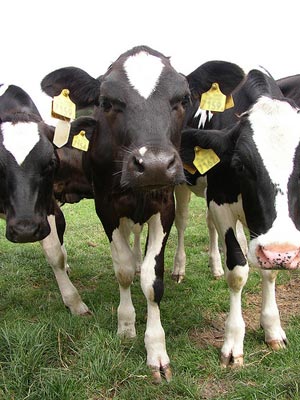
Two companies, Southdown Holdings and Five Rivers, have put an application in to start a dairy operation that would see 18,000 dairy cows housed in pens known as free stalls. You can see the application here.
What are these people thinking? And why are the Federated Farmers supporting them?
Apparently there is a plus side to this type of farming: it makes the ‘farmers’ more money; and it’s supposed to be kinder to the environment because the effluent can be easily collected.
On the negative side the animals need greater doses of antibiotics to prevent infection, plus they’ll be fed on grain, not clover or grass. Both of these things have an effect on the milk production. These chemicals leach through into the milk so that you and I end up drinking them, and being fed on grain will alter the taste.
What’s more the grain that they feed these animals is likely to come from palm plantations that are replacing natural rainforest. Any apparent lowering of the carbon footprint is more than offset by the fact that grain will need to be shipped in.
What’s more frightening is that this will irreparably damage our reputation as a clean green producer of sustainable sheep and beef meat, and milk. If a feed lot for dairy cows is allowed then the next logical step is that beef farmers will want to intensively farm their animals and we’ll end up like the US – crap meat, crap milk.
Why is the Federated Farmers supporting this move? They believe that this sort of farming should be encouraged. According to Federated Farmers President Don Nicolson:
This style of closed cycle farming means effluent can, for example, be put into bio-digesters with the resulting biogas used to power the farm offsetting farm animal emissions. Surplus energy could be sold into the national grid and all the while, nutrient loss is minimised.
This is what the emissions trading scheme is meant to encourage, isn’t it?
What he doesn’t take into consideration is the long term implications for New Zealand as a whole in allowing this type of farming. This isn’t a farm – it’s a factory. And the welfare of these animals is compromised as much, if not more, than the pigs in pens that caused so much controversy several months back.
Skinny, I feel you know as much about farming as I do about your trades
Giving cows shelter against the weather in Omarama is not factory farming
Grain does not come from palm plantations!
At the moment (I drove past the area today)rabbits take a cut lunch when they move across the flats, just about nothing grows there with out water because it is a waste land
I suppose it boils down to what people think is beauty and what rights the owners have to change their land
Like your work so please don’t take this as a personal attack
Hi Ray, no offence taken at all 🙂
On the grain/palm confusion – you are right that grain doesn’t come from palm plantations – my point is that cows are meant to eat grass, and in this case they won’t be.
Omarama has a harsh climate – freezing cold in winter and scorchingly hot in summer. Is this a good environment for cows? Probably not. Perhaps we need to accept this is not dairying country regardless of who owns the land.
And have you seen how much water is required to make this scheme work? The discharge of effluent is 308,000 litres per day on one farm and 560,000 litres per day on the other. I realise there’s crap mixed up in that but that’s a hell of a lot of water. Is there enough water in the Mackenzie basin to allow for this development?
The applicants for this farm are singing the virtues of the minimal environmental impact. That may be right but has anyone done a cost/benefit analysis of this venture against the money generated by marketing our clean green image for farming and tourism (regardless of the accuracy the ‘clean green’ is still a good marketing ploy).
And everyone seems to forget animal welfare here. A dairy cow with 6.25m of personal space is not a happy cow whichever way you look at it.
To anyone even remotely inclined to support factory farming of livestock, may I recommend that they check out “Food Inc”, a confronting film which investigtes the industrialisation of the US food industry. Segments dealing with factory farming of beef snd other creatures might give those who say farm effluent can be dealt with effectively cause for thought, to say nothing of extremely persuasive reasons to go organic, buy produce at farmers’ markets and hope to God that countries like New Zealand remain true to their long-applauded principles of ethical food production and a clean and green environment.
Although I have lived for the past 40 years overseas, I am so very proud to be a New Zealander, but if this McKenzie country dairy project should go ahead, it would be nothing short of shameful and I would feel profound disappointment in such a betrayal of all that I believe New Zealand represents to the rest of a grasping, greedy, unethical world.
Is there a site where signatures of those opposibg this project are being logged? Could you advise me of such.
With thanks.
Sue Girdwood.
Hi Sue
Thanks for your comment.
There have been developments around this – the whole project has been put on hold due to the Resource Consent process potentially costing up to $2.6 million.
http://www.odt.co.nz/news/politics/98284/mackenzie-country-faces-more-challenges-greens-say.